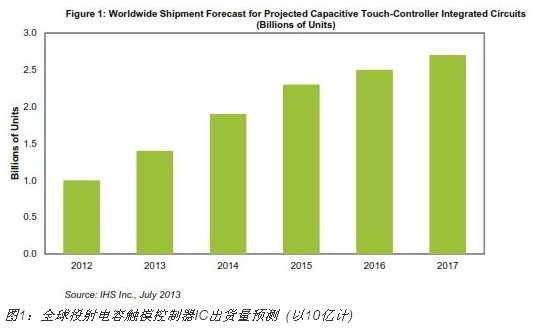According to IHS's Display Electronics Special Report, the projected capacitor (PCAP) touch controller IC market will grow steadily this year and in the next few years due to its widespread use in smartphones and tablets, but new applications such as ultra-thin PCs must also be used PCAP, so as to ensure the continued expansion of the industry. PCAP is used to implement touch screen functions. It is expected that the total shipment of PCAP touch controller ICs will reach 1.4 billion this year, a 40% increase from the 1 billion in 2012. In the next two years, it will continue to grow at a strong double-digit rate, and then will grow at a higher single-digit rate, at least until 2017. Shipments in 2017 are expected to grow to about 2.7 billion, as shown in Figure 1, the five-year compound annual growth rate is equivalent to 21%. PCAP semiconductor industry maintains expansion momentum The PCAP touch controller IC market continues to achieve strong growth through wireless products, especially mobile phones and tablets. Apple introduced the iPhone in 2007 and the iPad in 2010, bringing the touch display and touch-centric user interface we are familiar with today, creating the PCAP touch controller IC market. Since then, touch products have been enthusiastically sought after by consumers for their ease of use and sensitivity, and PCAP has also expanded to other products such as PC screens and car displays. Even so, adoption in other new markets will be critical to the continued growth of the industry. Although from the perspective of operating income, the wireless communication field will still be the largest touch controller IC application field, and it is far ahead, but its share of overall PCAP operating income will decline year by year. In order to compensate for the relative decline in the wireless field, other fields such as the ultrabook need to come up-this situation is expected to happen, the PCAP semiconductor industry can maintain the expansion momentum. PCAP is adopted by more products In the field of mobile phones, PCAP touch controller ICs are mainly used in smart phones or mobile phones with advanced operating systems. On average, each mobile phone has a touch IC. However, as the price of touch ICs continues to fall, these controllers will also enter more low-end mobile phones, namely feature phones. Second only to smartphones, media tablets are also an important area driving the growth of the PCAP touch controller IC market. The number of touch ICs used in various media tablets is different. IPads usually use more ICs, while smaller tablets use at least one touch controller. However, due to the expected increase in small-sized tablet models, and with the development of touch IC technology, even the use of fewer ICs in large-sized tablets in the future will be sufficient to meet the requirements, so the average PCAP touch controller IC used in each tablet Will continue to decrease. In terms of PC, the ultrabook will be one of the fastest growing fields in the next five years. This is mainly due to the strong support of Intel, which has made touch control the core of its ultrabook strategy. In addition to ultrabooks, other products that will help promote the growth of the PCAP market include touch screen-based all-in-one computers (AIO) and PC tablets. Touch technology is also being adopted in other markets, and PCAP will be increasingly used in LCD monitors and consumer electronics products, such as digital cameras, digital video cameras, e-book readers, and portable game consoles. Touch screen is developing towards lighter and thinner An important trend of the touch screen is to use in-cell liquid crystal panels. By integrating the touch screen with the liquid crystal panel, the touch screen can be made lighter and thinner. Apple's iPhone 5 launched in the fourth quarter of 2012 took the lead in adopting this technology. This trend will affect the PCAP touch controller IC, especially because it is related to the display driver IC that generates images on the device display. In order to achieve a smoother touch experience, two potential solutions may be used: combining the display IC and the touch controller IC in a single package; or combining the two ICs on a silicon chip. Although the combined solution may save space and reduce the overall system cost, the rate of product adoption will be slow. Even by 2016, touch products using single-chip solutions will be less than 20%, and most in-cell PCAP solutions will continue to be single-package variants. Laptops,windows Laptops,win11 Laptops,win10 Laptops Jingjiang Gisen Technology Co.,Ltd , https://www.jsgisentec.com
PCAP touch controller IC shipments will reach 1.4 billion